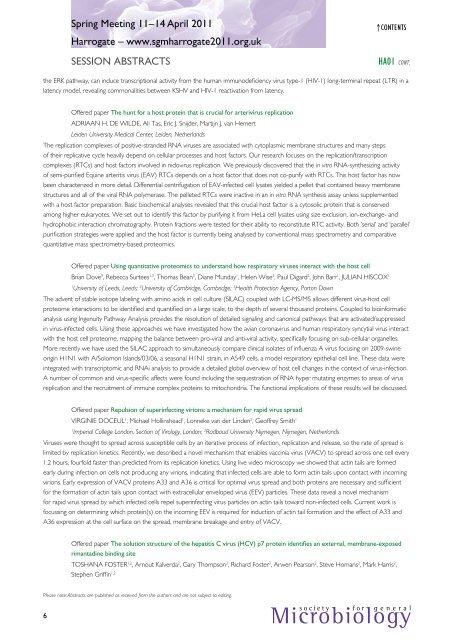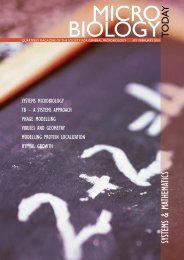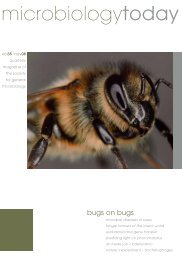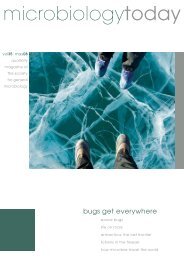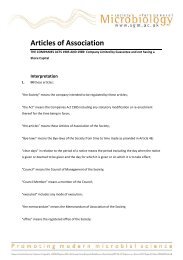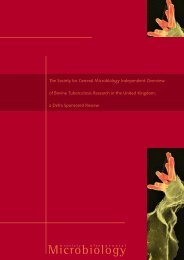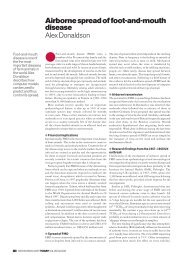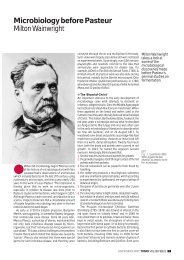Spring Conference 2011 - Society for General Microbiology
Spring Conference 2011 - Society for General Microbiology
Spring Conference 2011 - Society for General Microbiology
Create successful ePaper yourself
Turn your PDF publications into a flip-book with our unique Google optimized e-Paper software.
Please note: Abstracts are published as received from the authors and are not subject to editing.<br />
6<br />
<strong>Spring</strong> Meeting 11–14 April <strong>2011</strong><br />
Harrogate – www.sgmharrogate<strong>2011</strong>.org.uk<br />
SESSION AbSTrACTS<br />
↑Contents<br />
HA01 Cont.<br />
the ErK pathway, can induce transcriptional activity from the human immunodeficiency virus type-1 (HiV-1) long-terminal repeat (lTr) in a<br />
latency model, revealing commonalities between KSHV and HiV-1 reactivation from latency.<br />
Offered paper The hunt <strong>for</strong> a host protein that is crucial <strong>for</strong> arterivirus replication<br />
ADriAAN H. DE WilDE, Ali Tas, Eric J. Snijder, Martijn J. van Hemert<br />
Leiden University Medical Center, Leiden, Netherlands<br />
The replication complexes of positive-stranded rNA viruses are associated with cytoplasmic membrane structures and many steps<br />
of their replicative cycle heavily depend on cellular processes and host factors. Our research focuses on the replication/transcription<br />
complexes (rTCs) and host factors involved in nidovirus replication. We previously discovered that the in vitro rNA-synthesizing activity<br />
of semi-purified Equine arteritis virus (EAV) rTCs depends on a host factor that does not co-purify with rTCs. This host factor has now<br />
been characterized in more detail. Differential centrifugation of EAV-infected cell lysates yielded a pellet that contained heavy membrane<br />
structures and all of the viral rNA polymerase. The pelleted rTCs were inactive in an in vitro rNA synthesis assay unless supplemented<br />
with a host factor preparation. Basic biochemical analyses revealed that this crucial host factor is a cytosolic protein that is conserved<br />
among higher eukaryotes. We set out to identify this factor by purifying it from Hela cell lysates using size exclusion, ion-exchange- and<br />
hydrophobic interaction chromatography. Protein fractions were tested <strong>for</strong> their ability to reconstitute rTC activity. Both ‘serial’ and ‘parallel’<br />
purification strategies were applied and the host factor is currently being analysed by conventional mass spectrometry and comparative<br />
quantitative mass spectrometry-based proteomics.<br />
Offered paper Using quantitative proteomics to understand how respiratory viruses interact with the host cell<br />
Brian Dove3 , rebecca Surtees1,3 , Thomas Bean3 , Diane Munday1 , Helen Wise2 , Paul Digard2 , John Barr1 , JuliAN HiSCOx1 1 2 3 University of Leeds, Leeds; University of Cambridge, Cambridge; Health Protection Agency, Porton Down<br />
The advent of stable isotope labeling with amino acids in cell culture (SilAC) coupled with lC-MS/MS allows different virus-host cell<br />
proteome interactions to be identified and quantified on a large scale, to the depth of several thousand proteins. Coupled to bioin<strong>for</strong>matic<br />
analysis using ingenuity Pathway Analysis provides the resolution of detailed signaling and canonical pathways that are activated/suppressed<br />
in virus-infected cells. using these approaches we have investigated how the avian coronavirus and human respiratory syncytial virus interact<br />
with the host cell proteome, mapping the balance between pro-viral and anti-viral activity, specifically focusing on sub-cellular organelles.<br />
More recently we have used the SilAC approach to simultaneously compare clinical isolates of influenza A virus focusing on 2009-swine<br />
origin H1N1 with A/Solomon islands/03/06, a seasonal H1N1 strain, in A549 cells, a model respiratory epithelial cell line. These data were<br />
integrated with transcriptomic and rNAi analysis to provide a detailed global overview of host cell changes in the context of virus-infection.<br />
A number of common and virus-specific affects were found including the sequestration of rNA hyper mutating enzymes to areas of virus<br />
replication and the recruitment of immune complex proteins to mitochondria. The functional implications of these results will be discussed.<br />
Offered paper repulsion of superinfecting virions: a mechanism <strong>for</strong> rapid virus spread<br />
VirGiNiE DOCEul1 , Michael Hollinshead1 , lonneke van der linden2 , Geoffrey Smith1 1 2 Imperial College London, Section of Virology, London; Radboud University Nijmegen, Nijmegen, Netherlands<br />
Viruses were thought to spread across susceptible cells by an iterative process of infection, replication and release, so the rate of spread is<br />
limited by replication kinetics. recently, we described a novel mechanism that enables vaccinia virus (VACV) to spread across one cell every<br />
1.2 hours, fourfold faster than predicted from its replication kinetics. using live video microscopy we showed that actin tails are <strong>for</strong>med<br />
early during infection on cells not producing any virions, indicating that infected cells are able to <strong>for</strong>m actin tails upon contact with incoming<br />
virions. Early expression of VACV proteins A33 and A36 is critical <strong>for</strong> optimal virus spread and both proteins are necessary and sufficient<br />
<strong>for</strong> the <strong>for</strong>mation of actin tails upon contact with extracellular enveloped virus (EEV) particles. These data reveal a novel mechanism<br />
<strong>for</strong> rapid virus spread by which infected cells repel superinfecting virus particles on actin tails toward non-infected cells. Current work is<br />
focussing on determining which protein(s) on the incoming EEV is required <strong>for</strong> induction of actin tail <strong>for</strong>mation and the effect of A33 and<br />
A36 expression at the cell surface on the spread, membrane breakage and entry of VACV.<br />
Offered paper The solution structure of the hepatitis C virus (HCV) p7 protein identifies an external, membrane-exposed<br />
rimantadine binding site<br />
TOSHANA FOSTEr1,2 , Arnout Kalverda2 , Gary Thompson2 , richard Foster3 , Arwen Pearson2 , Steve Homans2 , Mark Harris2 ,<br />
Stephen Griffin1,2 s o c i e t y f o r g e n e r a l<br />
<strong>Microbiology</strong>


